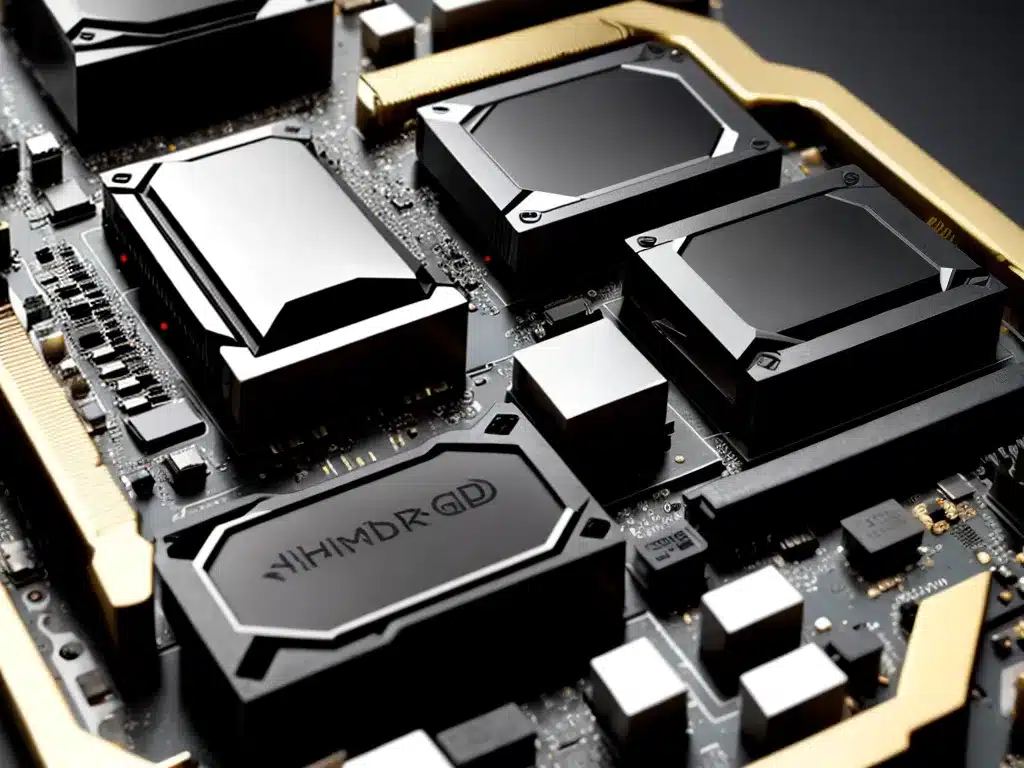
GPU memory technologies have rapidly evolved in recent years to meet the growing demands of graphics, AI, and other compute workloads. In this article, I will provide an in-depth look at the latest memory standards – GDDR6, GDDR6X, HBM2, and HBM2E – and explain how they differ in design and performance.
Overview of Key Differences
Here is a high-level overview of how these new memory types compare:
-
GDDR6 offers higher bandwidth and reduced power consumption compared to previous GDDR standards. It uses a 16nm manufacturing process.
-
GDDR6X further improves bandwidth by increasing the prefetch buffer and using new 16Gb density chips. It is optimized for bandwidth-hungry workloads.
-
HBM2 utilizes a silicon interposer and stacked memory dies for even greater bandwidth. It currently offers up to 307 GB/s per stack.
-
HBM2E improves upon HBM2 with increased density (8-Hi stacks), enabling up to 665 GB/s bandwidth per stack.
In summary, GDDR6/6X follow a more traditional memory design while HBM2/2E uses 3D stacking to achieve much higher throughput. But HBM comes at a higher cost and power.
GDDR6 Overview and Advantages
GDDR6 succeeds GDDR5 as the new memory standard for most graphics cards. It first appeared in Nvidia’s Turing architecture in 2018.
Compared to GDDR5, GDDR6 delivers:
- Higher memory bandwidth – Up to 16 Gb/s transfer speed per pin
- Lower voltage – 1.35V versus 1.5V
- Reduced power consumption – Around 15% lower per Gb/s
It achieves this through advances in fabrication and design:
- Manufacturing process – Uses a 16nm process versus 20nm/28nm for GDDR5
- PAM4 modulation – Allows 4 signal levels per transfer instead of 2
- Reorganized internal layout – Reduces latency and power draw
Overall, GDDR6 provides nearly double the bandwidth per watt compared to earlier standards. This allows graphics cards to have greater memory bandwidth without substantially increasing power consumption and heat output.
GDDR6X – Optimized for Bandwidth
GDDR6X is an enhanced variant of GDDR6, developed by Micron Technology for Nvidia. It first appeared in 2020 with the Nvidia RTX 3080/3090 GPUs.
GDDR6X improves bandwidth by:
- Increasing the prefetch buffer to 16n (versus 8n for GDDR6)
- Utilizing higher 16Gb density memory chips
- Further optimizations to reduce latency
This allows GDDR6X to reach speeds up to 21 Gb/s, approximately 30% faster than GDDR6. However, it comes at a cost of higher power consumption.
GDDR6X is tailored for extremely bandwidth-hungry applications like 8K gaming, AI, and professional visualization. It’s unlikely to fully replace GDDR6 due to its narrower use cases and higher TDP.
HBM2 (High Bandwidth Memory) Overview
In contrast to GDDR memory, HBM2 (High Bandwidth Memory) uses a fundamentally different approach to achieve greater throughput:
- Utilizes a silicon interposer and TSVs (through-silicon vias)
- Stacks multiple memory dies vertically
- Connects to GPU with very wide 1024-bit bus
This stacked design minimizes distance data has to travel between the GPU and memory, reducing latency. And the super-wide bus width allows HBM2 to reach 307 GB/s bandwidth per stack.
First generation HBM offered up to 128GB/s per stack, so HBM2 represents a giant leap in performance. It enables new capabilities for HPC, AI, and visualization workloads needing huge memory bandwidth.
However, drawbacks of HBM2 include higher cost, lower densities, and challenges integrating multiple stacks onto GPUs. So it is positioned as a specialized memory option, not a wholesale replacement for GDDR.
Introducing HBM2E – Higher Performance Stacks
HBM2E represents an evolution of HBM2 technology, offering higher bandwidth and capacity:
- Increased to 8-Hi stacks, up from 4-Hi for HBM2
- Enables memory dies up to 16Gb, doubling HBM2 density
- Optimizations reduce latency and power consumption
As a result, HBM2E can achieve up to 665 GB/s bandwidth per stack – over 2x more than HBM2. Capacities up to 16GB per stack are also possible.
AMD recently utilized HBM2E in their Radeon Instinct MI200 GPUs for data center and supercomputing. Nvidia also relies on HBM2E for their latest HPC offerings.
So while not mainstream yet, HBM2E pushes the envelope for applications needing extreme memory performance. Expect capacities and adoption to grow over time.
Conclusion
In summary, GDDR6 and GDDR6X represent a natural evolution of graphics DRAM – faster speeds via new fabrication processes and design tweaks. HBM2 and HBM2E take a more revolutionary approach, stacking memory dies for massive bandwidth.
Each memory type is suited for different use cases. GDDR6 offers the best blend of speed, power efficiency and cost for gaming. GDDR6X prioritizes utmost bandwidth for 8K and bleeding-edge workloads. HBM2/HBM2E provide huge throughput for HPC and AI, though at a premium price.
Going forward, expect continued innovation as memory tech strives to satisfy the ever-growing demands of high performance computing.












